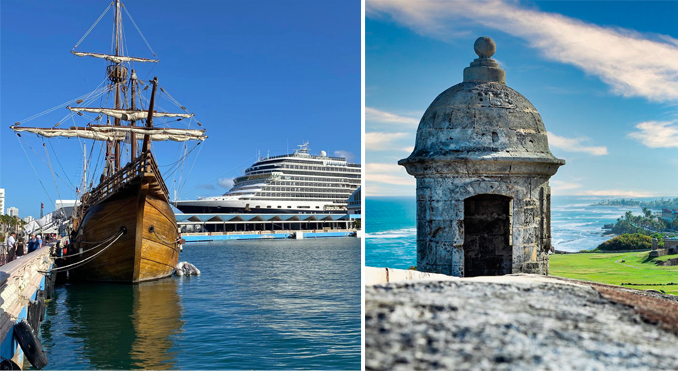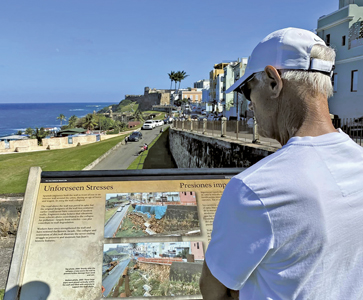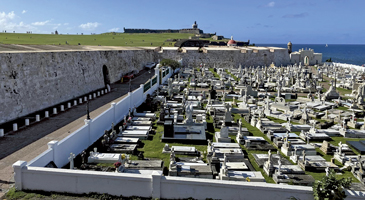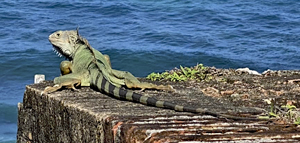
San Juan, Puerto Rico – 500 Years of History!

As you might remember from my last issue, Marcus and I, for the first time in our lives together, did not spend the holidays at home and/or with the kids. No Christmas tree decorating, no cooking, no dishes and no wrapping presents for under the tree. Instead we’d booked a Caribbean holiday cruise with Holland America and sent everyone e-gift cards before we took off! During our 2-weeks back to back cruise on the lovely MS Eurodam, we docked at several amazing locations, but one that really stood out for us was San Juan in Puerto Rico. We had no clue how incredibly beautiful and easy to explore Old San Juan is and can imagine maybe spending more time there. That’s one of the reasons why we love cruising, one gets to experience many new places and then find somewhere we might want to visit again. www.HollandAmerica.com
Puerto Rico (Spanish for ‘rich port’) is the Commonwealth of Puerto Rico, actually a Caribbean island and unincorporated territory of the United States with official Commonwealth status. It is located in the northeast Caribbean Sea, approximately 1,000 miles southeast of Miami, Florida. It has roughly 3.2 million residents, and its capital and most populous city is San Juan. Founded in 1521 by Spanish explorer Juan Ponce de León, the city’s colonial architecture and fortifications are some of its most notable features. And we love history!
MS Eurodam docked early in the morning at the Port of San Juan and we practically just walked off the ship and into Old Town history. The 83-foot topsail schooner Amazing Grace was docked just a few steps away from our cruise ship. The Amazing Grace is a replica of the traditional American sailing crafts and one may purchase tickets in advance and discover the city from the waters of historic San Juan Bay.
 We had a plan, and that was just the two of us enjoying a leisurely stroll through Old Town, take photos of the precious colorful colonial homes, view the historic forts and find lunch somewhere with a view, preferably where the locals eat. I almost instantly wanted to move there and we hadn’t even gotten as far as locating the white, sandy beaches. And as the languages spoken are English and Spanish, we could, couldn’t we!?
We had a plan, and that was just the two of us enjoying a leisurely stroll through Old Town, take photos of the precious colorful colonial homes, view the historic forts and find lunch somewhere with a view, preferably where the locals eat. I almost instantly wanted to move there and we hadn’t even gotten as far as locating the white, sandy beaches. And as the languages spoken are English and Spanish, we could, couldn’t we!?
We’d detected a tower of one of the forts already from our forward window on MS Eurodam on the 10th floor. As soon as we walked up the hill we found where it belongs to. Fort San Cristóbal, known as the “Gibraltar of the Caribbean,” is located on the eastern side of Old San Juan and in walking distance from El Morro. Construction on the fort began in 1634 and took over a century to complete. It is one of the largest Spanish forts ever built and supposedly the strongest in the Americas. It boasts walls that rise 150 feet above the sea, covers an expansive 27 acres of land, and has five separate independent units that inter connect via tunnels. Down in one of the tunnels you will find the dungeon with a death cell that had only a small window slit to light and ventilate it. This cell was for prisoners awaiting their execution. On the walls there are drawings of five ships done by an artillery captain. The ships have amazing detail right down to the flags identifying which ones belonged to the enemy.
The Castillo San Felipe de Morro, a stunning 16th century fortress. The Spanish constructed it to guard the entrance to San Juan Bay in 1540 and it took 49 years to build. In the 17th and 18th centuries, the Spanish built additions to the fort. It is a maze of barracks, tunnels, outposts, lookouts, dungeons, vaults and ramps. Forts El Morro and San Cristóbal along with 2.5 miles of city wall complete a fortification system that protected Puerto Rico, San Juan harbor and much of Spain’s interests in the “New World” from pirates and foreign invasion. Spain spent over 250 years building and fortifying this system considered “state of the art” for its time. Builders used the best engineering and architectural technology available at the time. Through this defense system, Spain controlled all access to the Caribbean, Mexico and South America.
 Overlooking the ocean and located amid the El Morro fort and Castillo San Cristóbal lays the historic sun-bleached cemetery of Santa María Magdalena de Pazzis cemetery. Known to locals simply as the Old San Juan Cemetery, it was officially established in the late 1800s and is the burial site of some of Puerto Rico’s most famous citizens. From inside the cemetery, there’s a great view of El Morro to one side, and La Perla to the other. Facing toward the island, you look upwards at the colorful houses of Old San Juan. In the center of the grounds is a small chapel, where you can get an elevated view of the nearby tombs, enjoy some shade, and feel the ocean breezes. Between the blue of the sky and the white of the headstones, it’s an unusual and at the same time beautiful and peaceful place to visit.
Overlooking the ocean and located amid the El Morro fort and Castillo San Cristóbal lays the historic sun-bleached cemetery of Santa María Magdalena de Pazzis cemetery. Known to locals simply as the Old San Juan Cemetery, it was officially established in the late 1800s and is the burial site of some of Puerto Rico’s most famous citizens. From inside the cemetery, there’s a great view of El Morro to one side, and La Perla to the other. Facing toward the island, you look upwards at the colorful houses of Old San Juan. In the center of the grounds is a small chapel, where you can get an elevated view of the nearby tombs, enjoy some shade, and feel the ocean breezes. Between the blue of the sky and the white of the headstones, it’s an unusual and at the same time beautiful and peaceful place to visit.
 A great lunch with a great view we found right along the scenic road, in a street side restaurant called La Vergüenza Puertorrican Chinchorro. People were waiting in line for a table, so we figured they must serve good food. And they did. We had some of the best fish tacos there on the balcony under a radiant blue sky, overlooking the turquoise ocean with a glimpse of El Torro to the right! La Vergüenza Puertorrican Chinchorro is an ocean-view rooftop bar and restaurant with some of the best views of the infamous La Perla neighborhood and the Atlantic Ocean. The restaurant specializes in Puerto Rican and Caribbean cuisine,
A great lunch with a great view we found right along the scenic road, in a street side restaurant called La Vergüenza Puertorrican Chinchorro. People were waiting in line for a table, so we figured they must serve good food. And they did. We had some of the best fish tacos there on the balcony under a radiant blue sky, overlooking the turquoise ocean with a glimpse of El Torro to the right! La Vergüenza Puertorrican Chinchorro is an ocean-view rooftop bar and restaurant with some of the best views of the infamous La Perla neighborhood and the Atlantic Ocean. The restaurant specializes in Puerto Rican and Caribbean cuisine, but it’s also a great spot to just grab a local beer, sit back, and enjoy the views. And we did.
but it’s also a great spot to just grab a local beer, sit back, and enjoy the views. And we did.
We both wished we’d more time to explore at least a couple of the interesting museums of San Jose and learn more about its culture but we had to be back on the ship by 5pm. On the list to explore the next time when we either stop here with a cruise ship or fly in for a few days is the Pre-Columbian Gold Museum. It houses a collection of over 1600 gold artifacts dating back as far as 500 AD. It is one of the largest collections of Pre-Columbian gold in the Americas. Also the National Museum of Costa Rica: Originally utilized as a military barracks during the 1948 civil war. It resembles a yellow fortress in San Jose’s city center. Even today, visitors can see hundreds of bullet holes that mark the walls. The Jade Museum: it houses the largest collection of pre-Columbian jade artifacts in the world. And then some. www.discoverpuertorico.com
On the way back to the pier through Old Town, along some of the precious old cobblestone streets, we found the Enchanted Coffee cafe! It was already 3:30pm and I’d started to get the heebie-jeebies for a caffeine fix. Wherever this coffee came from, it was one of the best e v e r! I wish I would have bought a pound or two.
Last year Puerto Rico celebrated its 500th anniversary of the founding of Old San Juan, the oldest city in the U.S. I always thought that Saint Augustine in Florida, founded in 1565, is America’s oldest city. But as it seems I didn’t read the fine print. Saint Augustine is the oldest “continuously occupied settlement of European and African-American origin in the United States”.
Escape From Paradise: www.EscapeFromParadise.net
www.facebook.com/ingrid.lemme #EscapeFromParadise
Award-winning TV Host, Publisher, Travel Writer.
Ambassador for www.Seven-Stars.com & 15 Emmy awards www.aTasteofHistory.org
www.twitter.com/LemmeEscape www.instagram.com/ingridlemme

